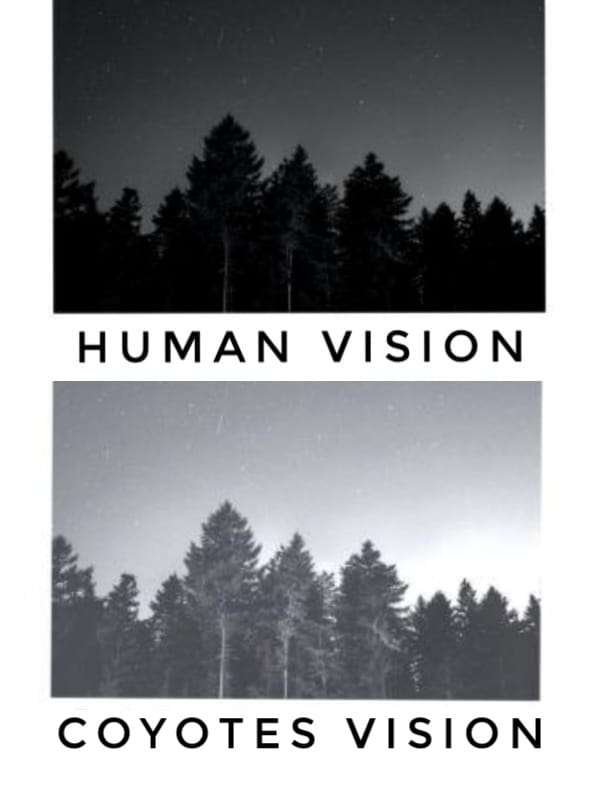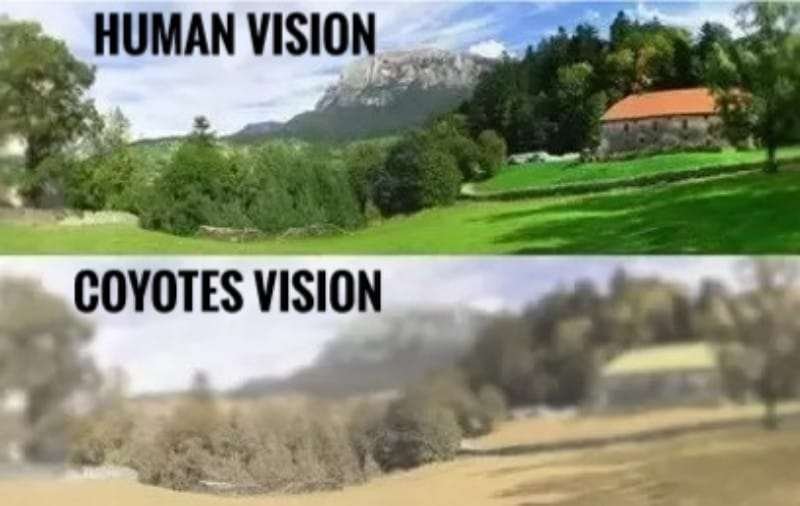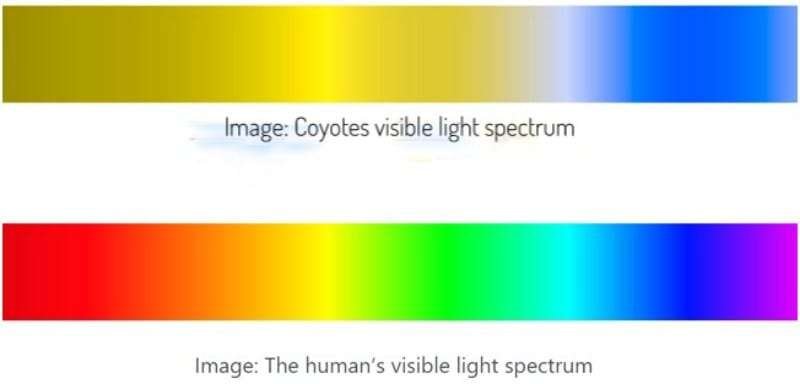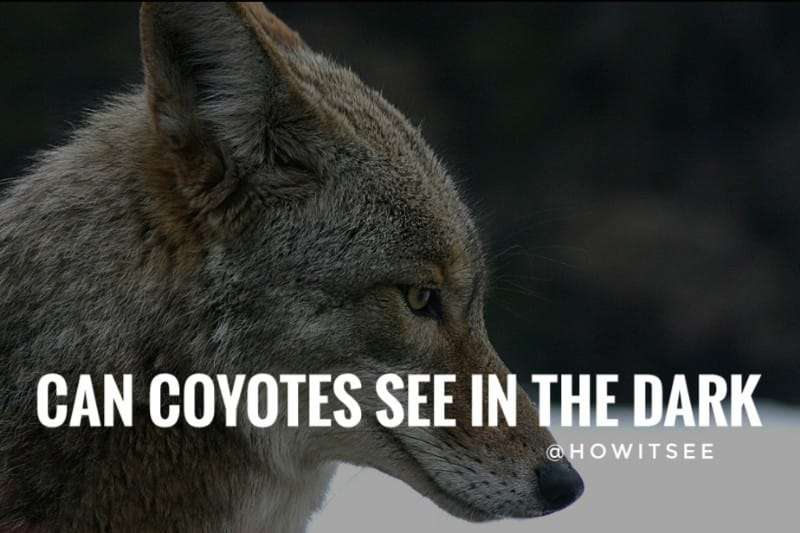Coyotes or Canis Latrans are canine species closely related to wolves and can only be found in North America. There are a lot of similarities between Coyotes and Wolves.
However, one primary difference is wolves are majorly nocturnal, but Coyotes are diurnal and carry out their most activities in the daytime. So, have you ever wondered how Coyotes see the world or are they able to see in the dark, similar to wolves? If yes, then below is the answer.
Coyotes can see much better in the dark as compared to humans. In addition, they can also see in the daytime but not better than us. They are not strictly nocturnal and can be seen at any time of the day, depending on different habitats.
Their vision allows them to glimpse both in the daytime and at night easily.
It is because Coyotes’ eyesight is concentrated towards more rod receptors than cones that are sensitive to low-light conditions.
Moreover, they have tapetum lucidum, a reflective membrane on the back of the retina granting them the ability of night vision.
Later in this post, we have discussed more on, “how Coyotes see in the dark and daylight” and how their vision is different from humans. Let’s discuss this.
Can Coyotes See in the Dark? Coyotes Night Vision
Like most canines, Coyotes can see seven times better than humans in the dark with the help of the rods present in their eyes. Rods have a photosensitive pigment called rhodopsin that helps to glimpse in low-light conditions.
Rods are susceptible to low light and require less brightness to activate, whereas cones need more light to react, which helps distinguish different color shades.
Human vision has more cones that allow us to differentiate millions of hues, whereas Coyotes have more rod ratio that assists them in witnessing at night. Rods cannot assist in recognizing colors; it only enhances black-and-white vision.
In addition, Coyotes have tapetum lucidum, a thin reflective membrane in their eyes. Have you emitted light on these animals at night?
If yes, then you will witness that their eyes shine. It is because of tapetum lucidum. It is a type of mirror-like tissue that collects the required light and re-emits it back to the retina.

It results in giving the rods a second chance to absorb visual information and increases the depth of night vision. And then tapetum lucidum reflects all unnecessary light back to the environment; that’s why their eyes glow.
With the help of both rods and tapetum lucidum, Coyotes can visually glimpse their surroundings easily in the dark. Their night comprises black and white shades similar to humans but with increased brightness.
A small amount of external light (like the moon or stars) is enough for them to witness nearby entities’ shapes, sizes, and movements in the dark. However, they are unable to see anything in the complete darkness.
In a nutshell, Coyotes’ eyesight works the same as other nocturnal animals, but unlike some nocturnal animals, they can also see in bright daylight. But their eyesight is not as sharp as humans. Let’s discuss this.
What colors can Coyotes see? Coyotes Color Vision
Coyotes are dichromatic and can see only blue and yellow colors up to 540 nm wavelength. They are not completely colorblind.
Dichromatic means they have only two kinds of cones in their eyes that help them to distinguish only blue and yellow colors. They recognize every other hue like red and orange as shades of gray.
On the other hand, humans are trichromatic, meaning we have three kinds of cones for small, medium, and large wavelength colors (blue, green, and red). That’s why we are able to recognize millions of color shades from 380 nm to 720 nm.
Coyotes have two cones only for small and medium wavelength colors up to 540 nm; that’s the reason they perceive higher wavelength colors in dull black and white.
Moreover, Coyotes are near-sighted with 20/75 vision or even worse. They see distant objects after 20 feet in dull. Below we have attached the image of how Coyotes and Humans see the world in the bright daytime.

In contrast, humans have perfect 20/20 vision, which aids us in seeing distant objects with details. However, Coyotes have one advantage over humans in terms of peripheral vision. Their eyesight covers around 260 degrees, whereas we have only 180 degrees of peripheral vision.
This is why it is essential to stay calm during Coyotes’ sightseeing. During the night, like us, Coyotes see everything in shades of black and white. But with the help of night vision abilities, they perceive everything with an increase in brightness.
In addition, many researchers believe that Coyotes can distinguish ultraviolet light up to a certain wavelength. There is a high possibility of it due to being dichromatic (the ability to see blue colors better than us).
What colors can Coyotes not see?
Coyotes are not able to see large wavelength colors like orange and red. They distinguish these large wavelength hues above 540 nm in shades of gray. They are dichromats and have the absence of L-cones in their eyes.

Moreover, Coyotes cannot see infrared light too. The only mammal that can see a tiny fraction of infrared is humans. Hence, in a nutshell, Coyotes cannot recognize many Secondary colors and Tertiary colors (like orange, violet, pink, magenta, cyan, etc.) that require red to form.
Can Coyotes see Red & Green Lights?
Coyotes cannot sense red light because they are dichromatic and unable to see higher-wavelength lights.
They categorize red light as a shade of gray at night. It is considered to be best to spot Coyotes at night.
However, one disadvantage of red light is that it doesn’t provide too much brightness in the dark, making problems for the hunters to see clearly.
Apart from the red light, many people suggest green light in the dark because green light is bright and can provide enough light to see in the dark.
It’s true that Coyotes cannot see the green light too. But its brightness will easily disturb them. They can sense green light as a shade of light gray in the dark and move away.
Coyotes Vision vs Human Vision
| Coyotes Vision | Human Vision |
| Coyotes are dichromatic and can see only blue and yellow shades. | Humans are trichromatic and can see blue, green, and red shades. |
| Their visions are nearsighted. | Our vision is far-sighted. |
| Coyotes have 260 degrees of peripheral vision. | Humans have 180 degrees of peripheral vision. |
| Coyotes have night vision and can easily see in the dark. | Humans do not have night vision. |
Coyotes possess remarkable visual adaptations that allow them to navigate and hunt effectively in low-light conditions, although their vision does not compare to that of true nocturnal predators.
While they cannot see in complete darkness, their excellent night vision is attributed to a combination of factors such as well-developed rod cells, a reflective layer behind the retina called the tapetum lucidum, and a higher density of photoreceptor cells.
These adaptations enable coyotes to see in dim light, detect movement, and perceive their surroundings more effectively during twilight hours.
By capitalizing on their visual capabilities and relying on other heightened senses like hearing and smell, coyotes have become highly adaptable and successful predators, expanding their range and thriving in various environments across North America.
Here, we conclude our article on “Can Coyotes See in the Dark” and explain its day and night vision. We hope you like this post. We will be back with another title. Till then, stay healthy, tuned with us, and read the articles mentioned below.
Also Read:

Meet Abhidept (nickname Monty), the visionary founder of How It See, being an engineering student, he’s fueled by an insatiable curiosity about the world around him. He is captivated by an eclectic correlation between animal groups, science, and nature, and this fascination drives his quest for understanding.
After completing his degree, he’s set on a mission to delve deep into the realm of nature, accumulating knowledge to share with you through his writing. In the meantime, he loves to watch anime and read anime.
